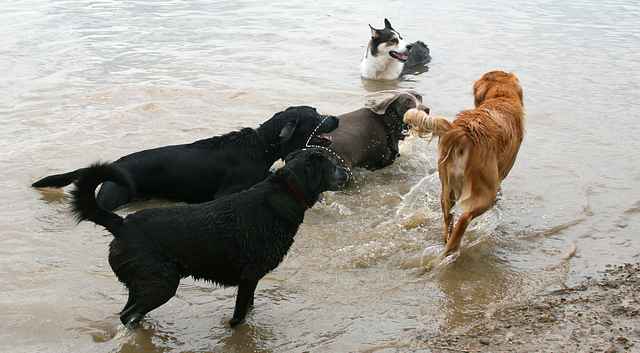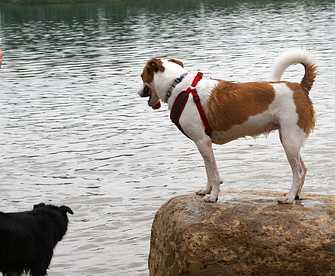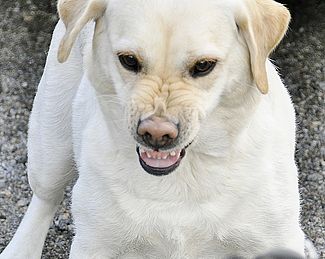by Debby McMullen (Victoria Stilwell’s “Positively”)
https://positively.com/contributors/consent-its-not-just-for-people/
When you go out in public to shop or recreate or just to simply walk about in your own neighborhood, is it your expectation to socialize or interact with every other human that you see? Most people would raise their eyebrows at such a suggestion. One needn’t be rude or openly hostile to others, but it is implied that we each have our own thing that we are attending to. We go about our day with the hope that we can achieve our goals without too much trouble and interference. If we want to socialize, we either happily take ourselves to places that are for the specific purpose of socializing or we invite people to our home. Makes sense, right? Yet we seem to expect dogs to feel differently about this sort of thing.
As a society that is comprised of mostly non-dog behavior experts, many people look at dogs as a sort of community property or at minimum, as some sort of entertainment that should be available to them, just because the dog is in a public place. This is rather a frustrating concept and if there were a way to wave a magic wand and educate a vast number of people that this is actually not an acceptable point of view, I can confidently state that a lot of dog behavior professionals would be waving such wands with an unrivaled enthusiasm. Since none of us have discovered this magical communication method as of yet, we do it the hard way, one at a time, with articles such as this and the others linked within. With the hope of educating, here are some examples.
Imagine that you are sitting in a public park with your family, well away from other park goers, simply enjoying a day out with loved ones. You suddenly you hear a voice at close range behind you, asking to touch one of your kids. You would be aghast and in disbelief, quickly looking around for your cell phone, in case you needed to call for assistance. There would be no question what your response would be. After all, your children are not public property, nor are they even property at all. It’s an inappropriate question at best. Now imagine that the kid in question is a dog. Why would your answer be any different?
Imagine that you are walking down a roomy public street, taking care to give others a respectful amount of personal space, when a passerby reaches out and deliberately strokes your arm. Are you alarmed and disturbed? Of course you are! You might even have a reflex physical response aimed at the offender, worried about why your body was intruded upon. Was it was an accident or on purpose? Now ask yourself why would your dog feel any differently about such an intrusion into his personal space bubble?
Imagine that someone you have just been introduced to reaches out and hugs you without warning. Their physical contact doesn’t end there. While hugging you, the stranger also strokes you on various body parts, while you struggle to try and pull away. They resist your protests and continue to touch you. No one would blame you for becoming defensively physical, in order to protect yourself. Sadly, this is what happens to dogs all over the country every day. At worst, their method of protest is a bite. This usually transpires when all other available pleas to stop are ignored.
These things all share the lack of consent in common. Consent is a right of every living being. We humans expect to be asked prior to being touched. Yet we give consent to others, often strangers, to touch our dog, without asking the dog if he wants to be touched. It is important that dogs be permitted to decline touch by strangers. It would lead to fewer clients for myself and other dog behavior professionals. But it would also lead to far more secure and happy dogs. Safety is way up there in the hierarchy of needs for any sentient being. Dog have just as much of a right to have a say in their safety as other animals.
As far as interactions with strangers when out and about go, my personal rule of thumb is that if I take one of my dogs to a public event, such as a pet expo or a play group, then of course I expect that my dog will interact with strangers, both canine and human. So it is my job, as a dog parent, to make sure that I take a dog that would enjoy such an outing. It is also my job to be mentally present and aware, so that when my dog shows signs of having had enough, I can be responsible and exit.
All other public presences do not mean that my dog is there for a stranger’s pleasure, just as a human child wouldn’t be. I expect to have that thought process respected. I will be my dog’s voice and I will vocally stop someone from moving forward to interact, becoming more forceful if need be. I am my dog’s safety and I never want them to have to feel vulnerable to encroachment on their personal space. I want them to look to me for protection rather than feel that they need to be pro-active. Forcing a dog to become proactive about his own safety is where reactivity/aggression often comes from.
I teach my clients the same thing. It is usually not enough to tell someone that one’s dog is not good with strangers. There are an abundance of people who think they are the exception to the stranger rule because they “are good with dogs”. Typically, that clues you in that you will need to be firmer with this sort of person. Feel free to loudly say that you dog is infectious or in training or anything that doesn’t have an exception. Please do not give out too much information. Don’t say that your dog isn’t good with strangers. In some cases, that gets you bullied, in others, that causes that “special” person to try and prove their exception to the rule. Be consistent, be vocal, be your dog’s gatekeeper. Your dog’s life may depend on this.
I do want to mention something that I see some people utilizing for dogs who are introverted; the leashes or coats or sashes that indicate the need for space. I do not personally support these products. Here’s one reason why. In THIS country, we have a litigious society. You are labeling your dog. If there is an unfortunate incident, you are already publicly stating that your dog doesn’t do well in close up circumstances and you are then admitting liability. I don’t believe in inviting controversy. There are plenty of people in this country who might consider forcing an encounter with the explicit purpose of being able to sue you. Just say no to labeling and speak out verbally instead. It is your right as your dog’s caretaker and never forget that. Do not be afraid. Your dog depends on you.
Another reason why I do not support labeling is because frankly, most dogs are not interested in interactions with random strangers. Being exceptionally social is a trait belongs to a very small portion of the dog world. I prefer education at large on this subject rather than simply labeling some dogs as abnormal. They are not abnormal. They are actually more the standard. We must stop trying to make them something that they are not and accept them for who they are. Education on this subject is vital.
Another part of public dog behavior education is children. Parents should be teaching their children that asking to interact with someone else’s dog is important. But they should also be teaching their children that the answer to “May I pet your dog?” may be no and that answer needs respected. There should never be an assumption or an expectation that anyone will/should say yes to that question unless, they are at a public venue specifically for that purpose, as previously discussed. Otherwise, a person/family outing that includes a dog(s) should be assumed to be just like any other family/person outing. Enjoying the outdoors on their own terms. It is understood that one doesn’t intrude on human only family outings as a general rule so why change that general rule simply because there is a dog present?
Something I often hear from people who are only used to dogs who are very social, is that they want to love on all the dogs that they see. It’s a very common reaction but we are a society that teaches that it’s not appropriate to act on urges that impose on others. This is included. Suppose you love children and want to love on all children that you see. Do you get it now? Acting on that urge will get the police called, wouldn’t you agree? Stifle your urges. Respect the being that you love. And above all ask first. And then accept the response to asking.
Each circumstance is different. While some people may not mind your request, their dog might mind very much. Since the dog’s personal space bubble is the one being breached, it behooves you to make sure that the dog in question doesn’t mind. There is an abundance of information available on the internet with regards to dog’s body language and what they try and convey to humans. If you truly love those dogs, as you profess to, then take it upon yourself to learn those body language signals that will enable you to determine whether the dog that you want to interact with, actually welcomes that interaction with you right back. Just because the dog’s owner thinks they do, doesn’t mean that the dog is in agreement with the owner. So be a true friend to dogs and arm yourself with this valuable information.
In other circumstances, both human and dog agree that the dog might want to mingle with you for a bit, AFTER you have politely asked both for permission, in an appropriate circumstance to do so. It then behooves you to interact politely, without too much in the way of familiarity.
Here is a great tutorial from Grisha Stewart on this subject.
After all, what kind of physical interactions would you permit from strangers on your first meeting ? Allow the dog the same courtesy please! The old adage that you should offer an unfamiliar dog a closed fist above their head is just crazy. Seriously, how would you feel about that particular offering?? Well, the dog is equally alarmed! A nice closed fingers hand with the palm up offered under the dog’s nose, without leaning over the dog is best if you offer a hand at all. But really, getting on the dog’s level, but in a sideways position, AFTER you determine that they are friendly enough to do so, is the least threatening position there is.
Once again, I come back to the most common of all response. The owner AND/OR the dog want their outing undisturbed. So many signals can give you this information. The first few of these signals are also exhibited by humans on outings, not looking to socialize with others: avoiding eye contact with strangers, physically creating space between others and themselves, walking in the opposite direction when it appears others might be encroaching on their space, using what appear to be distraction techniques that might involve food to help their dog ignore others in the environment, placing their body between the dog and an approaching human, and some really clear signals, verbally telling an approaching human to back off and/or placing their arm and hand in a stop signal like movement. If someone has to resort to the latter, then you have ignored the latter and seriously, shame on you! Let’s go back to the “dogs are not public property” sentiment and look at your own motives here.
Last, but not least is the common circumstance that arises in a dog’s own home. Family members are too intrusive, treating the dog like a stuffed toy, simply available for touching at a whim. While this is common with dogs who have long been a member of a family, it’s even more common when first adding a dog to one’s family. The expectation seems to be that since you have opened your home to the dog, you now have certain rights. However, the circumstances are similar to adding a new foster or adopted child to your home. You would want to get acquainted on each other’s terms, taking some time to get a feel for each other’s thought processes and quirks. Doesn’t your dog deserve the same respect as you would offer a human? After all, they don’t know who you are as a person. Being too intrusive physically too soon sets the wrong tone. It lacks respect for their ability to decide and to consent. So many shelter returns could be avoided by simply allowing a dog to get to know you and choose interaction. The amount of safety that decision would allow a dog to feel cannot be overstated. This kind of gift is priceless. Trust is offered so much more quickly when you offer respect. Make a dog happy and give them this kind of gift. Your heart will thank you.
A wonderful webinar on consent by the illustrious Grisha Stewart can be found here.
A final word on allowing a dog to consent to touch: the statistics on dog bites can be significantly reduced with this simple change to our interactions with this wonderful species. If you are in the area, consider signing up for Victoria’s Dog Bite Prevention Conference.
A caveat that goes with this article: I am not referring in any way to the required touch that is necessary to help a dog that needs medical assistance immediately. It’s equally stressful for the dog, to have no consent in those circumstances, as it is in the aforementioned scenarios. However, saving a life comes first. It does however behoove you as a dog parent, to spend some time planning and training for life saving touch necessities so that circumstances such as those can be as low stress as possible. I think this video is a wonderful teaching tool on how allowing one’s dog a choice with touching can help them allow it faster. This references ear drop treatments but the same philosophy and techniques will work for any touch desensitization.
Consent is a powerful thing. Don’t abuse it.
Post Date
February 9, 2017


 It’s a shame that the terms alpha and pack leader have become so closely tied to old-school, discipline and dominance-based training methods because the principles are still relevant and important. Some people may dislike the terms, but that doesn’t change the fact that someone has to lead, set the rules and keep the peace. In fact, the lack of leadership and structure is one reason some out-of-control dogs are surrendered to shelters by frustrated owners at their wits end. It’s also worth noting that every dog is different and some need more structure and guidance than others, but it should always be given via positive and humane methods built on trust and respect.
It’s a shame that the terms alpha and pack leader have become so closely tied to old-school, discipline and dominance-based training methods because the principles are still relevant and important. Some people may dislike the terms, but that doesn’t change the fact that someone has to lead, set the rules and keep the peace. In fact, the lack of leadership and structure is one reason some out-of-control dogs are surrendered to shelters by frustrated owners at their wits end. It’s also worth noting that every dog is different and some need more structure and guidance than others, but it should always be given via positive and humane methods built on trust and respect.



